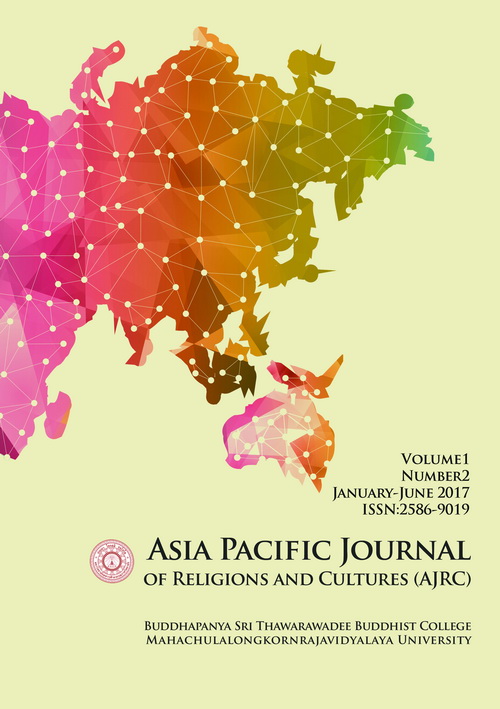An Elephant: A Religious Language to Peace Process
Main Article Content
Abstract
This article provides a survey of the Buddhist vision of peace in the light of an elephant as the symbolic religious language with the purpose of contribute to peace-building and peacekeeping in the world.Elephant’sforms are important part of Hindu Buddhist and other myths. Basically, the earliest available teachings of the Buddha are to be found in Pli literature and belong to the school of Theravda Buddhism. We can define the term ‘elephant’ in Pli such as “Hatthi-a male elephant, Hatthn-a female elephant”respectively”. In Buddhism, a white elephant is considered particularly auspicious, and is associated with the birth of the Buddha. From the Pli texts, the group of elephants can divide into two main groups namely: first group:-at the instance of the symbolic conflict such as Girmekhala, Nlgir, Mahilmukha etc., second group:-at the instance of the symbolic peace such as Paccaya, A white elephant, Prileyyaka, Bhaddavat and Ervan etc. The main characteristics of the elephant are strength and steadfastness. Therefore, elephant become a symbol of physical and mental strength, as well as responsibility and earthiness. Buddhism emphasizes on human effort, and has no faith in divine power that is why; it is called a non-theistic religion which believes in the ability of the human beings. The communication is a human need. In particular, the relationship between person in the society and social, all details about the profound to the religion and philosophy as well. The elephant as a religious symbolic language to peace-building namely: the symbol of physical and mental strength; having a good friend; training; the fulfillment of the perfection of charity; gratefulness; establishing oneself in heedfulness; excellent Omen; treasure and Four Noble Truths.
Article Details
References
Daw Mya Tin (tr.). 1190. The Dhammapada Verses & Stories. Delhi: Indian Books Centre.
Edward to Extract. Encyclopedia Britannica, Vol.8, Chicago: the University of Chicago.
G.P. Malalasekara. (2002). Dictionary of Pali Proper Names. Vol.I & II. Delhi: Munshiram Manoharlal Publishers.
H.R.H. Prince Chandaurinarunath, (1994). Pali-Thai-English-Sanskrit Dictionary. Bangkok: Mahajakut Rajavidyalaya Press.
I.B. Horner. (1995). The Collection of the Middle Length Saying, 3 Vols. London: PTS, 1954, 1959; and Tr. Nanamoli and Bodhi, The Middle Length Discourses, Boston: Wisdom Publications.
Mahathera Ledi Sayadaw. (1978). The Manuals of Buddhism (TheExpositions of the Buddha-Dhamma). Bangkok: Mahamakut Buddhist University Press, 1978.
P.A.Payutto. (1993). Toward Sustainable Science: a Buddhist Look at Treads in Scientific, Development. Bangkok: Buddhist Foundation.
P.V. Bapat (ed.). (1997). 2500 Years of Buddhism. New Delhi: Publications Division Ministry of Information and Broadcasting Government of India,
Phra Brahmagunabhorn (P.A.Payutto). (2012). A Constitution for Living,(119th ed.). Bangkok: Dhammasapa Press.
Robert C.Preble. (1962). Britannica World Language. Oxford: Oxford at the Clarendon Press.
Roshen Dalal (2006). The Penguin Dictionary of Religion in India. New Delhi: Penguin Books.
The Anguttara Nikaya. Vols. 20-24, Bangkok: Mahamakut Buddhist University Press, 2525 B.E.; Eds. R. Morris & E. Hardy, 5 Vols.
London: PTS, 1885-1900, The translated references are from TheBook of Gradual Sayings, tr. F.L. Woodward: Vols. I, II, & V; M.E.
Hare: Vols. III&IV, London: PTS, 1932-1936. Trs. F.L. Woodward & E.M. Hare, 5 Vols., London: PTS, 1955-1970 (Reprints).
The Dhammapada Atthakatha, Ed. H.C.Norm. The Commentary on the Dhammapada, 4 Vols. London: PTS, 1906; Tr. E.W. Burlingame, Buddhist Legends, 3 Vols.
The Digha Nikaya, Vols. 9-11, Bangkok: Mahamakut Buddhist University Press 2525 B.E.; Edss. T.W. Rhys Davids& J.E. Carpenter, 3 Vols, London: PTS, 1890-1911. Tr. T.W. & C.A.F. Rhys Davids, The
Dialogue of the Buddha, 3 Vols. Reprint, Delhi: Motilal Banarsidass,2000; (originally published London: PTS, 1899-1921). Also translated by M.Washe, Thus Have I Heard: The Long Discourses of
the Buddha, London: Wisdom Publications, 1987.
The Jataka. Eds. V. Fausböll, 6 Vols. London: Luzac & Co, 1877-1897;D.Anderson, Index to the Jataka and Its Commentary, London: Luzac& Co., 1877-1897. Tr. R. Chalmers, Vol., I; W.H.D. Rouse,
Vols. II and IV; H.T. Francis & R.A. Neil Vol., III; H.T. Francis, Vol. V, E.B. Cowell & W.H.D. Rouse, Vol. VI; The Jataka or the Stories of the Buddha’s Former Births, Cambridge: Cambridge University Press, 1895-1907, Reprint New Delhi: MunshiramManorharlal, 1990.
The Khudaka Nikaya, Vols.25-33, Bangkok: Mahamakut Buddhist University Press, 2525 B.E. The Majjhima Nikaya, Vols 12-14. Bangkok: Mahamakut Buddhist University Press.
The Vinaya Pitaka, Vols. 1-8, Bangkok: Mahamakut Buddhist University Press, 2525 B.E.; Ed. H. Oldenberg, The Vinaya Pitaka, (Texts), 5 Vols. London: PTS, 1997-2010,Tr. I.B. Horner, The Book of the
Discipline, 6 Vols. London: PTS, 1992-1993.
Ven.Jampa Choskyi. (2016). Symbolism of Animals in Buddhism.http://ccbs.ntu.edu.tw/ FULLTEXT/JR-BH/bh117490.htm, accessed on May 1.


